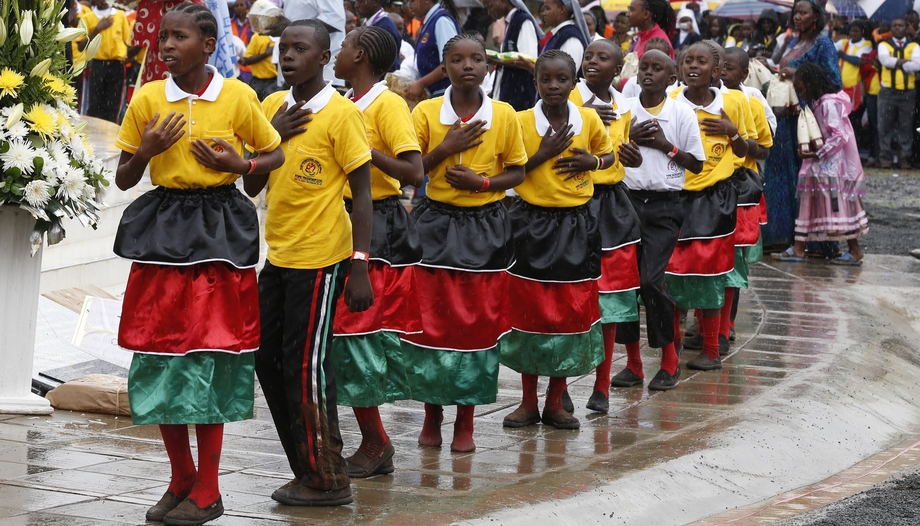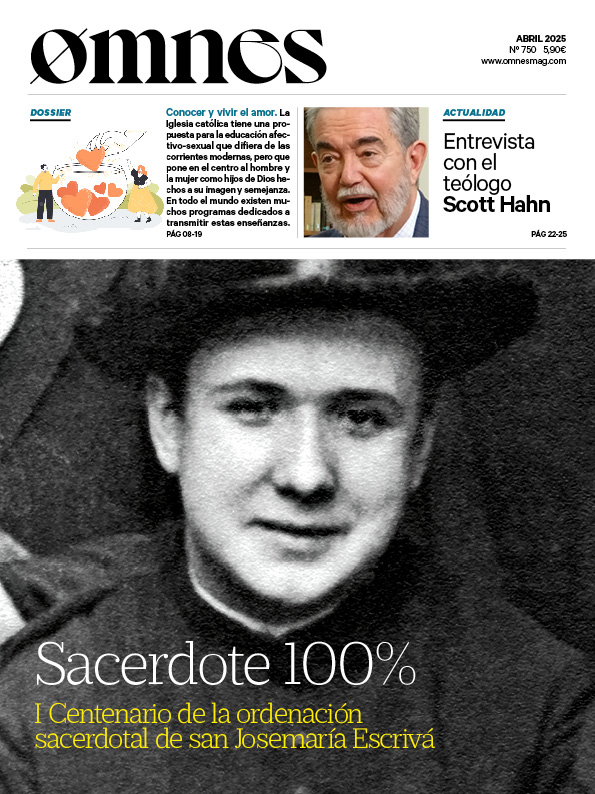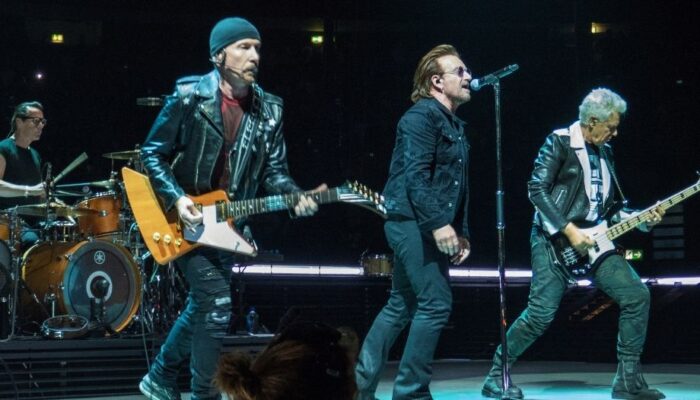When I was asked if I would be willing to write an article that could explain to non-Africans the role of music in liturgical celebrations in Africa, the email I received wanted me to focus on three important points: "the reasons for chant," "dance," and "the length of Masses in Africa."
I immediately thought of a statement that I keep hearing here in Europe: "Africans sing and dance during liturgical celebrations, and that's why their Masses last so long." The statement is not quite true, so it needs elaboration. Why do we Africans sing and dance during liturgical celebrations? Do Masses in Africa really last that long? As I am a son of Africa, I dare to answer these questions.
Why sing during liturgical celebrations?
It is very important to remember, first of all, that Africa has not invented its own liturgy. The Church in Africa follows the prescriptions of the universal Church regarding liturgy and tries to be always faithful to them. The Church, "the people of the New Testament," is the people of the New Covenant sealed with the Blood of Christ, but that does not mean that there is a break with the Old Testament. In other words, the Church has incorporated some acts of the worship of the people of Israel in its liturgysuch as, for example, singing.
In the Old Testament, the psalms are the prayer book par excellence. The psalms were meant to be sung. The Church has also maintained this same attitude towards the psalms and has used them more than any other book of the Old Testament. Moreover, in the psalms themselves, the psalmist never ceases to exhort the people to sing to the Lord God (cf. Ps 95:1-2; 45:1; 92:3-4; 104:33, etc.) Fidelity to the sacred liturgy demands that we sing during the liturgy, and we Africans do so with a heart full of joy.
– Supernatural General Instruction of the Roman Missal (GIRM) speaks of the importance of singing. "The Apostle admonishes the faithful who are gathered together awaiting the coming of their Lord to sing together psalms, hymns and inspired songs (cfr. Col 3,16). For singing is a sign of the exultation of the heart (cf. Ac 2, 46). Hence St. Augustine rightly says: "Singing is proper to one who loves," while the proverb goes back to ancient times: "He who sings well prays twice" (GIRM, n. 39).
Further on, the GIRM insists on giving great importance to the use of chant in the celebration of the Mass, always taking into account the culture of the people and the capacity of the liturgical assembly. Thus, chant is one of the elements of the liturgy that the Church has received from the Old Testament, and to which the Church in Africa tries to be faithful. It is in no way at odds with the norms of the universal Church. Singing during the celebration of Mass is biblical and ecclesial.
Africa and its culture
I would like to insist on the aspect of "culture" mentioned in the General Instruction of the Roman Missal. Every person has a culture, and culture is not static, it is dynamic. It is changing all the time. You are an African before you are a Christian. Even after baptism, you are still African. As the second reason why Africans sing and dance during the liturgy, it is important to understand what singing and dancing mean in African culture. The culture has many elements, one of which is music and dance.
The following description by John S. Mbiti, a former professor of Religious Studies at Makerere University in Kampala, Uganda in his book, "Introduction to African Religion," may help us understand something about African music and dance: "Africans are very fond of music. Therefore, music, dance and singing are found in all African communities. We also find many types of musical instruments, the most common being the drum. There are drums of many shapes, sizes and purposes. Some drums are used only in connection with kings and chiefs: these royal drums are often considered sacred and cannot be played commonly or by just anyone. There are war drums, talking drums, ceremonial drums, etc. Other musical instruments include xylophones, flutes, whistles, bells, harps, trumpets, lyres, mouth bows, zithers, violins, rattles and many others. They are made of wood, leather, gourds, bamboo, metal, sticks, tree trunks and even, nowadays, cans and jerry cans. Music is used in all activities of African life: in cultivating fields, fishing, herding, performing ceremonies, praising rulers and warriors, rocking babies to sleep, etc. African music and dance have spread to other continents (...) They are one of the main treasures of African culture and heritage".
Being very fond of music, an African understands very well the spirit of the Church's liturgy. He knows that the liturgical rubrics recommend that "absolute care should be taken to ensure that there is no lack of singing by the ministers and the people in the celebrations that take place on Sundays and feasts of obligation" (cf. GIRM, n. 40). However, Africans do not sing during the liturgy to promote their culture. The liturgy is not a place to promote any culture! They sing because singing is another way of praying to God (cf. Ex 15:1-2; Eph 5:19-20; James 5:13; Rev 14:2-3). In Africa, liturgical songs have been composed that lift up to God the prayer of blessing and adoration; the prayer of petition; the prayer of thanksgiving; and the prayer of praise.
Now let us look at another aspect: the dances. In one of his interviews in 2008, Cardinal Francis Arinze, being at that time Prefect of the Congregation for Divine Worship and the Discipline of the Sacraments, was asked, "Is there a time when dancing is allowed during Mass and also what about secular music?" His answer was very edifying. He said, "Dancing is not known in the Latin Rite of the Mass. Our Congregation has considered it for years. There is no major Church document on that, but the directive we give from our Congregation is this: in the strict liturgy (i.e., the Mass, the sacraments), Europe and America should not talk about liturgical dance at all, because dance as it is known in Europe and North America is not part of worship. So, they should forget about it and not talk about it at all. But it is different in Africa and Asia, not as a concession to them, but because their culture is different."
Therefore, we can speak of liturgical dance in Africa and Asia, but not in Europe and America. A non-African reader will ask: "But why?" Because the culture is different. Now, how is their culture different? The cardinal continued, "If you give a typical African the gifts to carry in the offering, and you give a typical European the same gifts to carry, if you don't see each other, the European will walk quite stiffly to the altar; the African will probably have movement: right, left. It's not a dance! It is a graceful movement to show joy and offering. Also in Asia they have refined movements that show respect, worship, joy."
Reverence for the sacred in Africa
Prior to the arrival of the Gospel message in Africa, traditional African religion surrounded every sphere of an African's life. One of the remarkable elements of this religion was the reverential awe of the "sacred". Wherever an African was, there his religion was with him: at home, at a meeting, in the field, etc. Because of this, even the songs and dances were respectful, to the point that they were an important part of the rituals.
With the arrival of Christianity, African dancing naturally fit into the liturgy that worships the true God. But it is not "dancing" in the sense that a European or an American understands it: a Saturday night dance: one man, one woman! That is a recreation that can in no way be included as part of worship.
I do not intend to "canonize" African dances and make people understand that all dance styles in Africa do not contradict the sacredness of the liturgy. By no means! Even in Africa there are dances that are not acceptable in the liturgy. Some are not acceptable at any religious event. The objectives of the Mass are four: adoration, contrition, thanksgiving and petition; and an African knows how to express externally these attitudes with his movements that are respectful and at the same time catechetical.
What Europeans and Americans understand as "dances," and which sounds a bit strange to them because of their concept of what a "dance" is, could properly be called "Body Language during the liturgy." Speaking of "body language," I find an English hymn called "Now Thank We All Our God" composed by Martin Rinkhart very enriching. It is a hymn of thanksgiving and look how it begins, "Now we all thank our God, with hearts, hands and voices..." The Mass is the celebration of the Eucharist. It is a thanksgiving. Our internal attitude during Mass must also be manifested externally. A human being is body and soul. We have to thank God "with hands and voices." Without room for exaggeration, during Mass our postures and gestures; our songs and "dances" should manifest what we believe and nourish our faith.
"Dancing" in the liturgy
Maybe my little experience in Europe can also help me to explain what I have called "Body language during the liturgy" as an explanation why Africans "dance" in the liturgy. Here in Europe people give a lot of importance to smiling. Why? The answer is easy: because actions often speak louder than words. It's not enough to say "I'm fine," people want you to show that you're really fine, and what helps to do that? A smile! So, now, what happens when we tell God that we are grateful, or that we feel Him, or that we adore Him from the depths of our heart, or that we are asking Him for some favor? Doesn't it seem right before God that we also show that externally with our postures and gestures?
I find the above explanation helpful because many times, when speaking of so-called "liturgical dances," one thinks of a celebration of Mass in Africa as a kind of "banquet" where people go to sing and dance, sweat and enter into a form of ecstasy before returning home on Sunday at noon. This is a mistaken understanding. Liturgical dances in liturgical celebrations in Africa are refined movements that must be understood in the context of liturgical gestures and postures. That being the case, these movements look towards the four objectives of the Mass: adoration, contrition, thanksgiving and petition. The bishops of each country monitor this, and dances that do not serve this purpose are normally forbidden.
The "long" Masses in Africa
Finally, let's say something about the length of Masses in Africa. This is a big debate among non-African Catholics. Many say that Masses in Africa last a long time. There are many Europeans and Americans who talk about it. Here it is important to ask ourselves some questions: Do Masses in Africa really last a long time? If so, why? Is it edifying or not edifying? Does it have to do with African culture? How long should the Mass last?
On my continent, there are many parishes where priests celebrate three or four Masses in the parish every Sunday: i.e., at 6:30 am, 8:30 am, 11:00 am and possibly 4:00 pm with children. Do these 2-hour Sunday Masses also fall into the category of "long Masses"? They certainly shouldn't!
However, we can consider another scenario. A Mass on the occasion of Priestly or Episcopal Ordination that begins with a procession at 9:00 am and ends at 2 pm. I think this second scenario is the one considered by many who speak of long Masses in Africa. Here it is important to be realistic: in Africa, the churches are full of people. The number of Christians continues to increase year after year. When you have feasts like ordinations, the number is even higher because numerous guests come to celebrate with their loved ones. So, a procession with 400 people takes time, more than one with 50 people. These people then bring their offering at Mass and many of them receive communion. All of that takes time, but, in reality, that's how long it has to take! We have to accept that while some celebrate in empty churches, others celebrate in churches full of people. This is no reason for some to be sad, we believe in one Church, holy, catholic and apostolic!
Catechesis and homilies
In addition to considering the number of those attending Mass in Africa, much has been said and continues to be said about the length of homilies. Many say that Masses in Africa take so long because priests preach so much. Yes, I personally know priests who preach for an hour at Sunday Masses. While it is true that a homily is not a class, shouldn't pastoral prudence guide a priest as to the length of his homily given the real situation of his flock?
In many parts of Africa, many young Christians attend catechesis before receiving the sacraments of Eucharist and Confirmation and after that only return for catechesis while preparing for the sacrament of Marriage. In this situation, one has to be careful with some ideas that may not be entirely positive for my African brothers and sisters.
I think Cardinal Robert Sarah, an African prelate, is absolutely right when he writes in his book, "It's getting late and it's getting dark": "What are the faithful going to feed on if they limit themselves to listening once a week to a ten-minute homily? To say that after ten minutes people stop listening is a lie: if their attention span is so short, how do they manage to spend hours and hours in front of the television?"
Perhaps this has something to do with African culture? Here it is important to underline that in Africa a feast is really a feast, just as a funeral is really a funeral! An African knows how to devote his attention, energy, resources and time to ensure that such moments are not denied their utmost importance. Therefore, it is reasonable for him that a great celebration such as a priestly ordination Mass or an episcopal ordination lasts four or five hours. Everyone present is happy and no one is in a hurry when it comes to such events. The quality of the moment is more important than the amount of time that passes. In Europe, perhaps people think in quantitative terms. So it is not surprising that many non-African Catholics are surprised by how long Masses take in Africa.
However, our praxis is not perfect, just as no praxis is perfect. There may be exaggerations here and there that make Masses in Africa take longer than they should. That is where catechesis has to play an important role, and thus make it possible to keep homilies short. We also have to train our dear Christians to avoid long, noisy offering processions, adorned with endless dances. Everything requires moderation. Let our struggle be to do all we can so that all who attend Mass participate with that "actuosa participatio" (active participation) of which the Second Vatican Council speaks. Of course, this has nothing to do with trying to argue about the maximum time allowed for a Mass.









